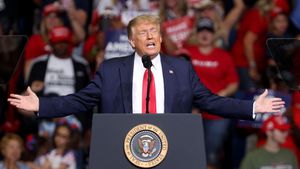The 2024 election is shaping up to be pivotal, especially on economic matters, with stark contrasts between Vice President Kamala Harris's and former President Donald Trump’s economic plans. For millions of Americans, particularly those from working- and middle-class backgrounds, the stakes are extraordinarily high. While Harris unveils strategies to reduce living costs across healthcare, housing, and childcare, Trump’s Project 2025 seems poised to enrich the wealthiest and loosen protections for average families.
Harris has been vocal about her commitment to assist working families, building upon the groundwork laid by President Biden’s administration. Her recent plans, as highlighted, include significant measures like capping insulin costs at $35 per month and making energy-efficient home improvements more accessible. These efforts reflect her continuous push for policies aimed at alleviating economic burdens on families.
A central focus of Harris’s platform is addressing the housing affordability crisis. She supports initiatives to increase access to affordable housing through programs aimed at first-time homebuyers and renters alike. This initiative emerges as housing prices continue to climb, placing enormous stress on American families eager to own their homes or find rentable spaces.
Harris is not stopping there; she also advocates for universal pre-K and debt-free community college programs, aiming to lessen the financial hurdles associated with education. Her proposals extend to affordable childcare programs and paid family leave, which promise to tackle the economic challenges faced by many parents, especially women, who find themselves juggling work and family unceremoniously.
Contrasting sharply with Harris’s comprehensive plan is Trump’s Project 2025, which critics argue would exacerbate existing inequalities. The former president appears to be favoring the wealthy and neglecting the needs of working-class families by proposing sweeping tax cuts for corporations. His approach would effectively raise taxes on middle-income households by eliminating key deductions, including the Earned Income Tax Credit (EITC) and the Child Tax Credit (CTC). For example, families earning $90,000 could see increases of up to $6,300, according to analyses of his economic framework.
Further scrutiny reveals alarming labor reforms within Trump’s agenda. If enacted, such reforms would weaken overtime protections and even curtail the rights of labor unions, undermining hard-won victories for workers. With labor unions regaining strength across several industries, such changes could significantly diminish the bargaining power of working families, trapping them in unfavorable employment conditions.
Yet another concern is the rollback on child labor protections as outlined by Project 2025. The possibility of minors working under hazardous conditions, such as those presented in meatpacking facilities, poses significant threats to formerly established worker protections. This trend is troubling and seems to be regressive, considering the rising rates of child labor violations already observed.
Among its proposed changes, Trump’s agenda also threatens to dismantle the Consumer Financial Protection Bureau (CFPB)—a pivotal organization credited with delivering over $19 billion in relief to everyday consumers wronged by predatory lending practices. The eradication of this safeguard could leave vulnerable families exposed to exploitation, deepening their financial distress.
When it regards infrastructure investments, Project 2025 seems equally problematic. By scaling back on initiatives focused on clean energy—critical during these times—Trump’s plan could jeopardize future job growth, particularly for blue-collar workers. This could halt progress made by efforts to strengthen manufacturing and construction sectors, which have been lifelines for many middle-class families.
A particularly contentious point is Project 2025's proposal to redirect the Federal Reserve's focus away from maximizing employment. Historically, the Fed's dual mandate has supported job growth and wage increases. Should Trump’s plan prevail, the real fear is the weakening of labor market opportunities, leaving workers trapped without leverage to negotiate fair pay or switch to new jobs.
The path forward could not be more distinct. On one side stands Harris’s agenda, fortified with specific, actionable proposals meant to alleviate economic hardships. On the other looms Trump’s Project 2025, which bears the risk of dismantling decades of progress, enhancing corporate gain at the expense of everyday families.
Turning to Harris’s economic vision, highlights include her Opportunity Economy agenda, introduced on August 16. This initiative is advertised as focusing on middle-class upliftment by providing housing assistance, lowering drug and grocery prices, giving tax breaks for small businesses, and enabling educational opportunities. Explicitly her agenda promises increased child tax credit expansion, which could potentially climb to $3,600 per child.
Critics highlight potential pitfalls. Some fear the vague nature of proposals, such as the tax breaks for small businesses, may not translate effectively to real-world benefits. Instances of increased governmental intervention—seen as somewhat heavy-handed by opponents—have raised eyebrows among economists. For example, criticisms have been levied against Harris’s plans to combat price gouging. Critics argue it serves more as political rhetoric than practical policy, as real inflationary pressures stem from broader government spending initiatives.
Even more concerning is the fear surrounding the housing assistance proposals. Harris aims to introduce first-time homebuyers' tax credits and seek out predatory investment practices, but skeptics worry such approaches could increase market demand without addressing the supply issue, pushing prices even higher.
Looking forward, if Harris’s proposals were to materialize, opposition claims suggest they could result in fiscal strain, requiring either significant budget cuts or increased revenue through tax hikes. The current budget deficit poses additional headaches as both candidates vie for public support from the middle ground.
Trump, on the other hand, is inclined to carry economic policies aimed at decreasing regulatory pressures and promoting tax cuts. His plan proposes sweeping tariffs, supposedly against foreign competitors, which, according to some estimates, could cost American households approximately $1,700 annually. Such tariffs fundamentally shift costs to the American consumer rather than addressing concerns with global trade practices. Consequently, these approaches may contain hidden costs for families reliant on affordable products.
The stark divergence between these two economic frameworks will sharply influence voter sentiment leading up to the election. Voters are expected to be drawn to the clear, specific programs proposed by Harris, which aim to alleviate burdens on families, compared to the perceived benefits favoring corporations within Trump’s plan.
Both candidates share the common ground of advocating for tax reforms and pledging to alter the effects of the expiring TCJA as they approach the election; yet, their methods appear polar opposites with distinctly different outcomes for middle-class taxpayers. These differences could well define the economic narrative leading up to November’s voting day.
While it is clear the economic stakes are at the forefront, the specifics behind how plans from both Harris and Trump will affect everyday families remain largely undefined and contested. Both sides will need to articulate not just visions but tangible impacts of their proposed economic transformations. Voters seem to be eager for more clarity about how these plans will re-shape the financial future within the confines of their households.
Overall, the upcoming election poses as much of a test for the economic strategies of both candidates as it does for the direction of the American middle class. With the economy being credited by many as the foremost issue influencing voter sentiments, how each candidate positions their economic policy could prove decisive.



